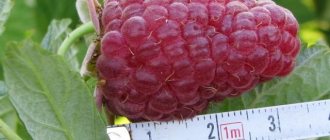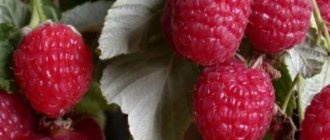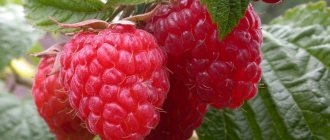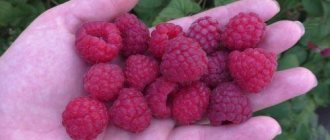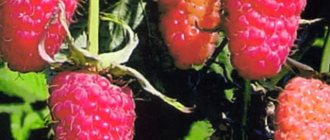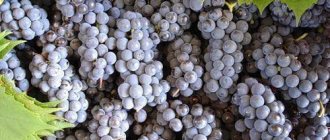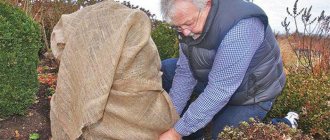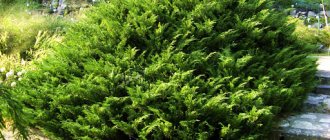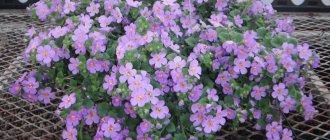The Bell raspberry was created specifically for regions with long, cold winters. Where other raspberries freeze, “Bell” grows safely and bears fruit. Let's learn about the features of planting and growing this frost-resistant variety.
Raspberry variety "Bell"
Raspberry fruits "Bell" are juicy with a pronounced raspberry aroma
The advantage of the “Bell” variety is the absence of shedding of ripe berries
Description of raspberry "Bell"
Brief botanical description of "Bell":
- Bushes. Medium height, dense and spreading. They look like bushy trees. They grow up to 2 m in height. The stems are strong and erect. There are many thorns on the shoots of the first year, but in the second year there are fewer of them, and the shoots themselves become woody.
- Leaves. Oval, green, petiolate, slightly pubescent with hairs.
- Roots. Powerful and thick, deepening to 40 cm.
- Flowers. White, up to 1 cm in diameter. This variety is a generous honey plant.
- Fruit. Bright red beautiful berries, having a conical shape, they resemble a bell.
The above-ground part of the shrub has a limited life cycle, but new shoots always grow to replace old, dead stems. Raspberry rhizomes produce two types of shoots - replacement and reproduction.
Description of the variety
Thanks to the excellent taste characteristics of the berries, unpretentiousness, drought and frost resistance, this raspberry variety has long been cultivated by many gardeners in the Altai Territory. For more than thirty years, Bellflower has acquired a lot of positive reviews, and the list of regions in which it is grown has expanded significantly.
You might be interested! Description of the second most popular variety of raspberry trees - standard raspberry Skazka.
Bush
Bell's bushes are medium-sized, reaching 1.5-2 m in height. On fertile soils, if all care rules are followed, bushes can grow up to 2.3-2.5 m. Shoot formation is average. Bellflower is a medium-ripening variety.
This variety is characterized by high winter hardiness (up to –25˚С –27˚С) and drought resistance. Rarely affected by spider mites. Resistant to many diseases characteristic of this crop.
Bellflower is a self-pollinating variety.
To obtain an excellent harvest of sweet, aromatic berries, seedlings must be planted in a sunny place. Lack of lighting affects the appearance of the bush and the quality of the harvest. The shoots become elongated, and the berries become smaller and have a sour taste.
The Bluebell raspberry has elastic, straight-growing shoots, and in the first year they have a pronounced green color. In the second year, the stems become woody and become grayish-brown, with small spots of purple on the sunny side, and a faint waxy coating.
The shoots of the first year are heavily thorned. There are no thorns on the shoots of the second year, but pubescence is present. In the upper part of the stem there is practically no edge, but the base is heavily pubescent.
The foliage of the Bluebell raspberry is large, wrinkled, light green in color, slightly curled. The lateral fruiting branches have a faint waxy coating. The flowers are quite large, up to 1 cm in diameter, the stamens are located below the pistils, the sepals are long.
Raspberry blossoms begin at the end of May in the southern regions, in regions with harsh climatic conditions - in the second half of June. The first wave of berry ripening occurs in early to mid-July.
The root system of the Bell raspberry is quite powerful, develops well, and deepens no more than 40-45 cm.
Berries
The berries of the Bell raspberry are large, weighing 2.9-4.7 g, have a standard bright red color, slightly pubescent. The shape of the berries is conical, slightly reminiscent of a bell, which was the basis for assigning such an unusual name to this variety. The fruits are juicy, have a sweet-sour taste with a pronounced raspberry aroma. According to the taste characteristics, the berries are rated 4.2 points.
The variety is characterized by an extended fruiting period. Ripening is undulating, raspberries are harvested at least 5-7 times per season. An additional advantage is the versatility of using ripe berries.
The undoubted advantage of the Bell variety is the absence of shedding of ripe berries. Raspberries perfectly retain their presentation and taste during transportation.
The yield of Bell raspberries is:
- per hectare - up to 105-120 centners;
- from 1 m² – 10.5-12 kg;
- from a bush – 5-7 kg.
Many gardeners claim that, subject to all rules of agricultural technology and favorable weather conditions, these figures can be increased by 30-40%.
Characteristics
"Bell" is successfully cultivated in temperate and northern latitudes. The main characteristics of the variety are in Table 1.
Raspberries are 80% water.
Table 1
| Characteristics/parameters | Description/meaning |
| Pollination | self-fertile |
| Ripening time | mid-season |
| Fruiting | continuous |
| First harvest of the season | July |
| Winter hardiness | high, up to minus 27°С |
| Drought resistance | high |
| Flowering period | starting in May, flowering lasts until August |
| Resistance to diseases and pests | under favorable conditions, the variety is resistant to all berry diseases and pests |
| Transportability and storage | They tolerate transportation well and are stored in the refrigerator for about a week without losing their taste or presentation. |
| Productivity | 2-7 kg per bush, per 1 ha – 110 c |
| Berry weight | 3-6 g |
| Taste and aroma | sweet and sour taste with a delicate aroma, tasting score – 4.2 |
| Purpose | fresh consumption and processing - desserts, jams, freezing, liqueurs, wines, liqueurs |
| Recommended Regions | Central regions, Volga-Vyatka region, Volga region North-West, Western Siberia, Ural |
An overview of the Bell raspberry variety is presented by the gardener in the following video:
Description of fruits
The good thing about this variety is that it is self-fertile. In addition, the raspberry bush is distinguished by incredibly beautiful red fruits, which slightly resemble a bell when ripe. Hence the name of the variety. These are hairy drupes.
The berries are large and can weigh from 2 to 6 grams. The shape of the fruit is conical. Breeders note that a positive feature of “Bell” is the fact that the berries never fall off, unlike other varieties of raspberry bushes. This means that after assembly they will last longer and have an excellent presentation.
The taste of Bell raspberry is pleasant, honey-sweet, not cloying. The grains of the berries are soft and melt in the mouth without creating a hard sensation on the tongue. The juice is spicy with a subtle hint of bitterness from the grains. Tasters gave them a score of 3.8 points out of 5. The berry consists of 70-85% juice.
More on the topic: Remontant variety of raspberries Joan Jay (Joan G)
Productivity
In the brief description to the registration sheet, the high yield of the variety is noted; the average figure is given - 105-120 c/ha. In terms of 1 sq. per meter of planting this will be 10.5 - 12 kg, or 5-7 kg per bush (approximately).
According to the gardeners themselves, the harvest sometimes exceeds the specified amount, but this can only be with good care of the plant plus favorable weather conditions.
Selection of seedlings
To avoid buying wildflowers or bushes dug up from an abandoned dacha instead of the desired variety, buy raspberry seedlings only from nurseries. Amateur gardeners often do not monitor the purity of the variety; moreover, their seedlings are infected with infections and pests.
How to choose good seedlings:
- The root system should be powerful, branched, and fibrous.
- The roots are elastic, dense, saturated with moisture. Unacceptable signs - rotting, wilted appearance, curling
- The best option is seedlings in containers with a closed root system. Such raspberries take root better, and they can be planted at any time except winter,
- There should be 2-5 shoots - this sign indicates the plant’s readiness for active development. The thickness and length of the stems are not particularly important - they still have to be cut to 10-30 cm,
- The seedling must have at least three buds at the base.
Pruning and preparation for winter
In autumn, fruit-bearing shoots are removed from the trellises and cut at a height of 5-8 cm from the ground. Excess annual shoots are also mercilessly cut out. One bush should contain no more than 4-6 young shoots that will bear fruit next year.
The raspberry bush is cleaned and, if necessary, a layer of mulch of 8-10 cm is laid to prevent freezing of the root system.
There are no clear recommendations regarding covering raspberries for the winter. It all depends on the region and its climatic features.
In areas where winter frosts of -35/-40˚C are not uncommon, annual shoots of the Bell variety must be bent to the ground so that they do not freeze. But in the central and southern regions this procedure can be abandoned.
Advantages and disadvantages
Advantages of the Bell variety:
- The berries, when ripe, do not fall off.
- They are well transported and stored, and do not lose their presentation for a long time.
- It bears fruit in the second year after planting the seedlings.
- High productivity. Fruiting is almost continuous; the variety produces 6-7 harvests per season.
- Small number of thorns.
- Large and tasty berries with excellent presentation.
- Resistant to spider mites and purple spot.
Flaws:
- Increased lighting requirements.
- Increased foliage of plants.
- Under the weight of the fruit, the shoots bend down - a garter to the supports is necessary.
- Insufficient resistance to fungi.
- Does not tolerate prolonged waterlogging of the soil.
- Regular pruning and thinning are required.
- Does not tolerate drafts well.
Flaws
But there are also some disadvantages:
- The leaves of the bushes grow very quickly, covering the clusters with ripening berries; they constantly need to be thinned out;
- the brushes on the shoots bend to the ground under the weight of large fruits, it is necessary to tie them up on trellises so that when assembling you do not have to bend over and hold the stem with one hand and pick the berries with the other;
- raspberry Bluebell is afraid of drafts and stagnation of moisture in the root zone; in such cases, the bushes often get sick, the foliage and stems dry out, and the roots are affected by root rot;
- the variety is very sensitive to light; with a lack of sunlight and strong shading, raspberries ripen poorly, become small, and lose their sweetness.
Boarding rules and conditions
In order for the Bell to grow and bear fruit safely, you must start by following the rules for planting it:
- The berry garden is set up in an area well lit by the sun, protected from wind and drafts.
- Raspberries should not be planted in areas with high groundwater levels. The maximum proximity of water to the surface is 1.5 m. Also, lowlands in which water accumulates - melt or rain - are not suitable.
- It is not recommended to set up a raspberry garden near fences, sheds, or other buildings. Even slight shading for 2-3 hours has a negative impact on the yield and quality of berries.
- Any soil is suitable, the main thing is that it is loose, fertile, and has neutral acidity.
- The soil prepared for planting seedlings is dug up, removing weed roots, and fertilizers are applied.
- Seedlings are planted in the spring - early April, or in the fall - a month before frost. Autumn planting occurs in the first half of October.
- The seedlings are planted in pre-dug trenches or holes. Their width and depth are 40 cm.
- Bell raspberries are planted in rows using the ribbon method. The interval between rows is 2-2.5 m. Between bushes is 1-1.5 cm.
- It is desirable that the rows are located from east to west. In this case, the rays illuminate the shoots well, and the berries are formed at a height of 60 cm or more from the surface of the ground.
- Trellis with two thick wires are placed along the rows - shoots are tied to them. From the ground to the bottom wire - 60 cm, to the top - 150 cm.
Landing
It is permissible to plant the plant in both spring and autumn. Growing Bluebell from seeds at home is not easy, since it is a fairly lengthy procedure. In addition, this method does not guarantee the preservation of raspberry varietal characteristics. It is recommended to grow and propagate the plant by dividing the bush, which, as a rule, is not particularly difficult.
In the second year of life, the Bluebell will have a large number of basal shoots; the longest and most viable of them should be separated from the common rhizome, preserving a couple of good roots. This should be done in the autumn in the process of preparing the plant for wintering.
It should be noted that during this period, summer residents often have a large number of healthy plant seedlings left, which gardeners, as a rule, throw away due to uselessness. Thus, if the site does not yet have the Bell variety, you can borrow or purchase a couple of seedlings from other summer residents. Most likely, gardeners will be only too happy to give them away, because this option is definitely better than simply throwing away the seedlings.
When planting a plant, you should adhere to the following tips:
- Choose the site for planting wisely. You should choose an area that is sufficiently illuminated by sunlight. Many gardeners, due to lack of space, plant plant bushes along the fence or against the walls of any buildings, which shade the raspberries for a significant part of the day. In this state of affairs, the plant simply will not be able to properly develop and bear fruit.
- If there are a large number of seedlings and the corresponding area, it is recommended to plant the plant in columns, leaving 2 m between them. It is important to mention that seedlings should be planted approximately at a distance of a meter from each other.
- In addition, it is necessary to ensure that the soil in the space allocated for the Bell is fertile and loose, as well as intermediate in acidity. However, such conditions are quite common for summer cottages.
Step-by-step instructions for planting Bluebell
The procedure for planting raspberry seedlings “Bell”:
- The site is dug up, adding for each square meter:
- 2 buckets of compost or rotted manure;
- half a bucket of wood ash;
- 50-60 g double superphosphate;
- 80-100 g of potassium sulfate;
- 2 buckets of sand - for clay soils.
- Dig holes or trenches.
- Slate or metal sheets are buried around the perimeter to prevent the growth from spreading.
- A mixture of fertile soil and fertilizers is poured into the holes or trenches (the dug soil is mixed with humus, rotted cow manure, potassium sulfate and superphosphate). The recesses are filled to half. The amount and composition of fertilizers depends on the characteristics of the soil and the time of planting. 5 kg of humus/compost, 10 g of potassium sulfate, 20 g of double superphosphate and 250 g of wood ash are added per bush.
- Seedlings are placed in holes or trenches. The roots are carefully straightened so that they look in different directions. The seedling is shaken when digging in so that the soil fills all the voids. Cover the roots with soil and compact it with your hands.
- The plantings are watered with water and then sprinkled with suitable mulch - humus or peat.
When planting, the replacement bud should be several centimeters above the surface of the earth; it cannot be buried in the soil.
Characteristic features of the variety
Since the bell originated in Siberia, its main feature is frost resistance. The bushes can survive cold temperatures down to -40°C with proper preparation for wintering. They tolerate temperatures down to -20°C without additional insulation.
But this is not the only distinctive feature of the variety:
- Bluebell berries do not fall off after ripening;
- juicy fruits – 70-85% juice. Store refrigerated for up to 7 days;
- the taste of the berries is sweet and sour;
- the aroma is pronounced.
The fruits can be eaten after picking or used for preservation. From a culinary point of view, the variety is universal.
Important. Despite its origin, Bluebell raspberries need a lot of sunny color. In shaded areas it will ripen slowly and bear sour fruits.
Fruiting of one bush
Bellflower is a self-fertile variety, that is, the harvest can be obtained even from a single bush on the site:
- weight of berries – 2-6 g;
- the plant bears fruit in waves, 4-7 harvests per season;
- Over the course of a year, one bush produces from 2 to 8 kg of berries.
Productivity depends on the growing region, weather conditions and care of the raspberry tree.
Interesting. Although Bluebell berries are very juicy, at the same time they have a dense structure. Therefore, they are well stored and can withstand long-term transportation.
Advantages and disadvantages
The benefits of Bell include:
- frost resistance;
- large berry size;
- non-susceptibility to spider mites and some other diseases traditionally considered the scourge of raspberry trees.
The disadvantages are the same as those of other raspberry varieties: light-loving, intolerance to waterlogging and drafts.
Aftercare for raspberries
“Bell” is cared for by performing standard measures provided for by the agricultural technology of this crop. In addition to watering, weeding, fertilizing, pruning, mulching and loosening, this variety benefits from garter.
Irrigation scheme
Raspberries should not be over-watered; they are watered as the soil dries out. Approximately 5-7 waterings are carried out per season, depending on the weather. Table 2 shows an approximate scheme for watering raspberries.
table 2
| Period | Number of waterings |
| Before flowering | 1 |
| During the filling of berries and their ripening. | 2 |
| After fruiting. | 2 (plus 2 more as needed - in case of heat and drought) |
During irrigation, water should wet the soil by 20-40 cm. Per 1 sq. m of berry garden spend 30-40 liters of water.
Weeding, loosening and mulching
They loosen and weed the Bell at least 2-3 times a season. The depth of loosening is 6-7 cm. You need to step back 1 m from the bush. Once or twice a month, the raspberry tree is mulched - a layer of humus is poured between the rows. This is beneficial for the roots and promotes active bud formation.
Top dressing
In the first year, after planting, the raspberries are not fed. From the second year, fertilizers are applied according to the standard scheme for raspberries:
- Every year, in the spring, rotted manure is added. For 1 sq. m – 5-6 kg. Urea is also added. For a bucket of water - 4 tbsp. l. This is enough for two bushes. Feeding option – 60 g of superphosphate, 40 g of potassium salt, 30 g of ammonium nitrate.
- In the summer you can apply the following fertilizer complex - 40-50 g of urea, 200-250 g of superphosphate, 60-70 g of potassium sulfate.
- One year they give organic matter, the next year they give minerals. An option for autumn feeding is 50 g of superphosphate and a glass of wood ash. The second option is 300 g of ash, sugar and manure, and 3 student crayons.
Raspberries are fed 3 times per season - in spring, summer and autumn.
Garter
The variety is large-fruited, so the branches experience significant stress, they bend toward the ground and often break. To prevent this from happening, the bushes are tied to trellises. The garter also contributes to uniform illumination of the fruits, and the crop ripens together.
Trimming
Raspberries are trimmed:
- Leaves. In raspberry bushes, if they are very thick, the foliage is thinned out with pruning shears - it prevents the berries from ripening.
- Stems. When fruiting ends, the shoots are untied from the trellises and pruned, retreating 6-8 cm from the ground. Annual shoots are also pruned, leaving no more than 4-6 pieces on the bush.
Preparing for winter
For the winter, the Bellflower bushes do not need to be covered. In the southern regions, preparation for winter is limited to trimming the stems. In regions with harsh winters (-40 °C), young shoots are bent to the ground and covered. But a layer of mulch - humus or peat - won't hurt. Layer thickness – 10 cm.
Lighting requirements
To plant the “Bell”, it is advisable to choose a place with maximum lighting. This will ensure timely ripening of the fruits, their pleasant taste, as well as the harmonious development of the bush itself.
If there is not enough light, the shoots will soon become very elongated and obscure the branches with fruits. Thus, the berries will begin to deteriorate rather than ripen.
More on the topic: Remontant raspberries Indian Summer
It is for this reason that it is necessary to ensure that the bush is not too dense. In the spring, it is customary to “clean” raspberries from old branches and excess young shoots.
Diseases, pests and their control
"Bell" has earned a reputation as a variety that is resistant to diseases and pests. But under unfavorable conditions and poor agricultural practices, he is prone to suffer from ailments common to raspberries. The variety can also be affected by common pests of raspberry trees. Tables 1 and 2, respectively, show diseases and pests that most threaten the Bell variety, as well as measures to combat them.
Table 1
| Disease | Symptoms | How to fight? |
| Gray rot | The fungus affects all above-ground parts - a gray coating appears. | Treatment of bushes and soil with HOM. For 10 liters - 40 g. The solution is enough for 1 hundred square meters. |
| Anthracnose | Fungal disease. White-gray spots bordered with red appear on the stems and leaves. | Spraying bushes and soil with 1% Bordeaux mixture. |
table 2
| Pests | Damage caused | How to fight? |
| Raspberry beetle | The larvae deform the flowers. They can completely destroy the crop. | In May, berry fields are sprayed with Fufanon. |
| Raspberry fly | The larvae gnaw through leaves and stems. | 2 weeks after spraying with Fufanon, the berry plant is treated with Iskra. Insecticides are used when 50% of plants are affected. |
Agrobiological characteristics
The growth vigor of the bushes is average, and therefore the shoots reach a height of 1.5-2 meters. The dimensions of the plants are moderate due to the not too much spreading of the stems, which opens up the possibility of relatively dense planting. Young shoots grow straight, firm and elastic, greenish in color with areas purple from anthocyanin pigmentation on the sunlit side. There is a waxy coating on the surface of the stems, as well as noticeable pubescence, the intensity of which decreases from the base to the top. The spines are very rare and are located on a dark purple base. By the second year, the color of the raspberry shoots becomes gray, the appearance is geniculate, the pubescence at the base is preserved, but the spurs are completely absent, which allows you to safely garter the stems, harvest the crop and remove fruit-bearing vegetative organs. By the way, tying the shoots to the trellis is required in both the first and second years of their life, because otherwise, young stems risk being damaged by strong winds, and fruit-bearing stems risk falling to the ground under the weight of the harvest. The leaves of the variety are complex, connecting three or five simple leaf blades with moderately long petioles. The latter grow medium or large, oval in shape with a pointed end. The leaf color is usually light green, the texture is wrinkled, and the profile is slightly curled. Along the edges of the leaf there are numerous small triangular teeth. Fruitful branches are formed in significant numbers, have several orders of branching and bear up to one and a half dozen or even more ovaries. The surface of the laterals is covered with a light waxy coating. They are quite durable, and therefore can withstand the weight of a ripening crop well. Root shoots of the Bluebell are formed in quite large quantities, and in order to prevent the raspberries from spreading throughout the entire area, as well as to maintain the cleanliness of the rows, a lot of effort will have to be made to eradicate the shoots. A large amount of it takes away strength and nutrients from plants, as a result of which productivity sharply decreases. Preserving some of the offspring is justified only if it is necessary to obtain planting material for propagation.
According to the type of fruiting, our hero belongs to the traditional varieties that form a harvest on two-year-old shoots. The period of its flowering depends on the climatic conditions of the growing region, and may occur in May or early June. At this time, the bushes acquire a very beautiful decorative appearance due to numerous large flowers. Their sepals are long and pubescent, and the stamens are located below the pistils. Fruit ripening occurs in the mid-early period, but usually it is extended in duration up to a whole month from the end of June to the beginning of August. In this regard, the harvesting frequency can reach 5-7 times, which is not very convenient for farmers, but it allows amateur gardeners to feast on fresh raspberries for a long time. The gross yield per season for bushes that are properly cared for can reach high values of 2-3 kilograms or more, and in large areas, up to 110-125 centners of raspberries are harvested per hectare of industrial plantings. Considering the adaptability of the variety to the harsh conditions of Siberia, such productivity can be considered excellent for these places.
The ripening berries are quite large in size, reaching a height of 16−18 mm and a diameter of 17−19 mm. Their shape is rounded or wide-conical with a blunt tip, the color is bright red, the average weight is 3-4 grams. There is a slight shine and slight pubescence on the surface, which does not at all spoil the attractiveness of the appearance. The drupes of the Campanula are moderately fastened to each other and therefore do not fall into fragments without the application of mechanical force. The berries are easily separated from the fruit stem, but practically do not fall off on their own. When chewed, the pulp of the fruit is juicy and tender, tastes sweet and sour, and has a noticeable “raspberry” aroma. The dry matter content in berries averages 11−13%. The juice yield reaches 80%, the seeds and dense parts of the pulp do not exceed 18−19% by weight. The sugar content of the juice is quite good - 6-8 g/100 ml. There is no data on testable acidity, but judging by the harmonious taste of the berries, we can conclude that this parameter is moderate. Vitamin C, which largely determines the benefits of raspberries for the body, is present in the fruits of our hero in an amount of 40-45 mg%. The taste qualities of the berries during tasting are estimated at 3.8−4.2 points, depending on the growing conditions. The abundance of sunlight falling on the plants has a particular influence on the gastronomic characteristics of the variety. Bushes located in the shade or cultivated in regions with frequent cloudiness naturally produce a harvest of worse quality than those that are sufficiently illuminated.
Use of berries
“Bell” is a universal variety - its berries are eaten fresh, decorated with various dishes and baked goods, desserts are prepared, compotes, jams, marmalades, and jelly are made. Raspberries are also used in the preparation of sauces for meat dishes, added to cakes, made fillings for pies, and prepared alcoholic drinks (wines, tinctures, liqueurs) and non-alcoholic drinks (fruit drinks, lemonades, cocktails). And raspberry jam is the most delicious of its kind.
Dry raspberries are a powerful anti-cold remedy. They are brewed and drunk for the flu, and also as a preventive measure for cardiovascular diseases. Raspberry decoctions and infusions are beneficial for the kidneys and liver, and help with rheumatism and gout.
History of the appearance of the variety
Breeders from the Siberian Research Institute of Horticulture worked on the creation of the Bell. Lisavenko (Barnaul, Russia). They developed this variety as a result of selecting the best seedlings after open pollination of the Carnival variety.
The bell was tested for less than 10 years. In 1991, the variety was included in the state register and its cultivation was recommended in the West Siberian region.
Over the past 30 years, this frost-resistant variety has not only spread throughout Russia, but also gained popularity in other European and Asian countries, as well as in North America.
Similar varieties
Raspberries are classified according to various characteristics - by the size of the fruit, by the type of fruiting, by the color of the berries and by many other characteristics. "Bell", when compared with other raspberries, has in common with the following varieties:
- By regionality. In the Urals and Siberia, along with Kolokolchik, the best varieties are considered: Amateur Sverdlovskaya;
- Biryulevskaya;
- Zorenka Altai.
- For Health;
- Zorenka Altai;
As you can see, with two varieties – Blestyaschaya and Zorenka Altai – there was a coincidence in two characteristics at once.
Reviews
I chose Bell based on reviews on purpose. I needed raspberries that bear fruit between early and late varieties, have high yields and good frost resistance. I have a small raspberry garden and its main task is to supply the whole family with fresh berries for as long as possible. The bell suited my needs perfectly. Early raspberries begin to run out, this variety appears, almost simultaneously the cherry bears fruit, a little later the plum and apple trees, in general, I’m always on vitamins. What else I liked about the reviews about the variety is that it was bred in Altai and is intended specifically for successful cultivation in the Urals and Siberia. For me, as a resident of Nefteyugansk, this was also very important, because... The harvest is good, but the variety still needs to survive the winter successfully, and I had problems with this before. The bluebell overwinters, one might say, excellently. I actually cover it with non-woven material, but I also carried out this procedure with other varieties and they still froze.
I bought Bell raspberries after the old variety was destroyed by purple spot. The nursery said that there are now quite a lot of varieties that have good resistance to diseases and pests, and they recommended “Bell.” I’ve been growing this variety for four years now, and it seems like they didn’t deceive me, the raspberries are healthy, the bushes are powerful, and the foliage is plentiful. The harvest is also decent. In addition, I am a gardener who can visit my plantings only on weekends, so watering, mulching, frequent weeding or loosening is out of the question. I’ll water the cucumbers and tomatoes, but there’s no time left for raspberries. And this variety seems to “sorry” me. Like, the owner can’t follow agricultural practices, but I’ll still pamper you with delicious raspberries.
For three decades, the Bell raspberry variety has shown itself only on the positive side. High yield, large fruit, drought and frost resistance, high resistance to fungal diseases and insect pests are just part of the undoubted advantages of the variety. And the Bluebell really deserves to have a plot allocated for it in every garden.
Reviews from gardeners about the variety "Bell"
★★★★★
Victor P., N. Novgorod. The variety is very frost-resistant and tolerates drought well.
I collect up to 7 kg of berries from a bush. Maintenance is simple, the main thing is not to fill it with water, protect the plantings from winds and drafts, and tie them to trellises. The downside is that there are thorns and you have to wear gloves to pick the berries. We eat berries all summer. ★★★★★
Alevtina P., Novosibirsk region. The variety is undemanding, even without special care it yields 5 kg per bush.
The berries are sweet and tasty, but not juicy enough. Therefore, the best use for them is to use them in jam and compotes. Moreover, you can make preparations all summer; some berries run out, and new ones immediately grow. For three decades, the Bell variety has proven that unpretentiousness combined with productivity is always in trend. Gardeners, appreciating the positive aspects of this variety, are actively growing it in different regions of Russia.
0
0
Copy link
How to propagate the Bellflower variety
Bluebell propagates mainly by vegetative methods:
- basal shoots;
- cuttings;
- dividing the bush.
All these methods help preserve the varietal characteristics of the original bush, and are quite easy to implement.
The Bell variety is grown by seeds extremely rarely. Moreover, such an event requires special skills. In addition, propagating raspberries by seeds takes a lot of time and effort, but does not guarantee the preservation of the plant’s varietal characteristics.
Variety selection
Siberia became native to “Bell”. It was there that it was obtained by pollinating the free genus of the raspberry variety "Carnival". This was done by breeding scientists from the Research Institute named after M.A. Lisavenko of the region. This raspberry was accepted for the state variety testing process back in 1982. In 1991, “Kolokolchik” was officially included in the state registration list of the West Siberian region. Soon this variety began to appear in other regions and even countries.
Thanks to its winter hardiness, raspberries can be found in Russia, Ukraine, Belarus, Romania, and other countries in Asia, America and Europe.
Did you know? They talked about raspberries back in Ancient Rome, in the 3rd century BC. According to legend, the berry is bright red because the goddess wanted to feed Zeus with it and injured her hand until it bled while picking the fruit on sharp thorns.
Harvest and storage
It is recommended to pick berries in dry and clear weather. In the morning, while dew remains on the fruit, and immediately after rain, it is better not to do this: the raspberries must be completely dry.
This must be done very carefully, without throwing or dropping it. Despite the density of the berries of this variety, it is worth separating them from the fruit stem carefully so as not to crush them.
If the berry is being prepared for transportation, then the fruit is left, cutting or pinching off from the stalk itself
It is important to avoid over-ripeness and harvest summer berries as soon as they turn red.
Did you know? At the end of the 19th century, Swiss scientists were able to create a variety with purple berries by crossing bushes with red and black raspberries.
It is better to prepare the container in advance, because whole and damaged berries must be placed in different containers. If the fruits are collected in jars, then it is necessary to ensure their cleanliness, and if in baskets, then it is better to cover them with newspaper
It is important to know that pouring berries from one container to another is unacceptable: this can damage the integrity of the fruit
For temporary storage, you need to choose a dry, dark and ventilated room. At a temperature of 0°...+0.5°C and a humidity of 85%, the berries can stand for up to 5 days, then they can be frozen on plastic trays and transferred to bags.
Raspberry Sokolica was bred at the Institute of Horticulture in Brzezne and is considered a fairly new variety, however, it continues to actively conquer the domestic market due to its resistance to disease and heat.
A large harvest, large and sweet berries, good transport tolerance and early ripening make the variety convenient for both country and commercial cultivation. The main thing is to follow agricultural practices and provide the plant with proper care.
Diseases and pests
The Kalashnik is sufficiently resistant to various diseases and pests, but with reduced immunity and an unfortunate location it can be affected by the following diseases:
- Curly. It is carried by aphids and appears on shoots with small corrugated leaves. There will be few berries on such a plant, their taste will be sour.
- Mosaic is also spread by aphids and affects leaves and root shoots, where green or yellow mottled spots will be visible. The plant is stunted in growth, the berries are dry.
- Overgrowth. It is carried by leafhoppers and produces many small, thin shoots with chlorotic leaves. A year after infection, the plant stops bearing fruit.
The listed diseases are viral and affect the planting very quickly. Plant productivity decreases by 50–75%, and after 3-4 years they die. An effective treatment has not yet been found, so infected bushes are dug up and burned.
Important! Raspberries are not replanted in the area where viral diseases were discovered.
Fungal diseases spread when plantings are densely planted in damp weather. The most typical characteristics of raspberries are:
- anthranosis, which is noticeable on all parts of the bush with gray spots with a purple rim, gradually developing into ulcers;
- Septoria blight appears in June on leaves and shoots in the form of brown spots, which then lighten and become covered with black fungal pycnidia. Even after the plant freezes, the fungus survives until spring and can infect the bushes for another 2 years;
- Didimella attacks the buds and stems, producing light purple spots that then darken. This mushroom can grow in winter, ringing the shoot, which dies by early spring.
To prevent fungal diseases, it is important to maintain the distance between plants in planting. Since the fungus overwinters in the soil, autumn digging with the application of fertilizers is recommended.
Before the buds open, in early spring, they are treated with a solution of Bordeaux mixture (4%).
Spraying three times with a 1% solution of Bordeaux mixture during the growing season is also effective:
- at a shoot height of 15–20 cm;
- before flowering;
- immediately after flowering.
Find out how to deal with worms in raspberries.
Landing Features
By following the basic rules for planting raspberries, you can significantly increase the chances of rapid rooting, as well as provide the plant with a quick start in the spring.
Did you know? If there is an apiary next to the raspberry field, the crop yield will increase by 60–100%.
Deadlines
The crop can be planted in spring or autumn. The choice of season depends on the climatic conditions of the region. The most optimal planting is considered to be autumn planting, in late September - early October. Its advantages are:
- sufficient humidity combined with low air temperature. In the south, spring can be sultry, which is why the young seedling may die or rooting will take much longer;
- before the onset of cold weather, the seedling will grow new roots, and in the spring it will immediately begin to grow;
- with autumn planting, you can harvest the crop already in the first year, but spring planting will delay fruiting and, most likely, the berries will not have time to ripen.
The planting time also depends on the type of seedling. A plant with an open root system is planted earlier than one with a closed root system, since open roots will take longer to take root in a new location.
In the spring, plants are planted in those regions where autumn is short and the seedling does not have time to take root before the onset of stable frosts.
Choosing a suitable location
For remontant raspberries, the choice of planting site is more important than for classic varieties. The plant does not like drafts and requires full sunlight. A favorable planting location will be the area near the south side of the fence or house, provided that there is no shadow on the bushes from them. Raspberries cannot be planted after potatoes, tomatoes and strawberries due to “common” pests and diseases.
It is worth considering that the groundwater in the area should not come closer to the surface than 1.5 m. The recommended soil is light and fertile, and in case of high acidity, add dolomite flour or fluff (4–6 kg per m²).
The root system of remontant raspberries differs from the traditional one in being longer, so the hole for it should be deeper, about 60 cm. 2 buckets of humus, 200 g of “Nitroammofoska” and 300 g of ash should be added to it.
Selection and preparation of planting material
To avoid getting a plant of an unknown variety, it is better to make a purchase at a trusted nursery or large garden center. A specific seedling must meet the following characteristics:
- have 1–3 mature shoots 5–8 mm thick;
- if the root system is open, it should be fibrous and developed, with root shoots 15–20 cm long.
A plant with an open root system must be wrapped in a damp cloth and moistened periodically. Before planting, it is recommended to dip the roots in a mixture of clay, mullein and “Kornevin”.
Landing algorithm
Remontant raspberry varieties are planted in separate holes, which can be arranged in rows. The distance between plants in a row should be 50–70 cm, and row spacing should be 1.5–2 m.
The technology for planting seedlings is as follows:
Form a mound of soil at the bottom of the hole. Spread the roots of the plant on it and carefully cover it with soil, carefully compacting it. The root collar should be at soil level. Cut shoots to a height of 20–30 cm, remove foliage. Water the bush and mulch the tree trunk with sawdust, peat, and wood chips.
Raspberry variety Mirage
Variety Mirage. Late variety, annual shoots are not thick, there are many thorns.
We have not yet encountered these varieties in Siberian gardens. Getting seedlings in Moscow is not a very simple matter now, and propagation by seeds, it seems, is still unreliable, although seed sellers assure that the properties are completely reproducible. In addition, varieties bred for the Non-Black Earth Zone may not be winter-hardy enough in our conditions. Since the characteristics of these varieties are very tempting, they will probably appear with us over time.
https://agronomu.com/bok/5169-malina-kolokolchik-harakteristika-plyusy-i-minusy.html
https://ferma.expert/rasteniya/kustarniki/malina/kolokolchik/
